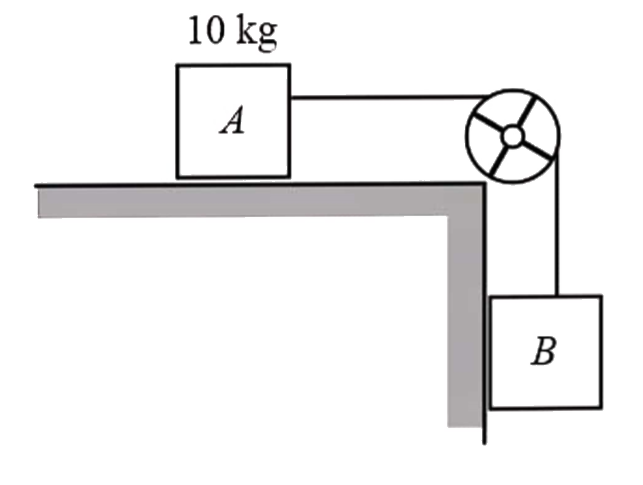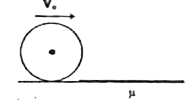In Fig. a stationary block explodes into two pieces L and R that slide across a frictionless floor and then into regions with friction, where they stop. Piece L. with a mass of 2.0 kg, encounters a coefficient of kinetic friction μL = 0.35 and slides to a stop in distance dL =0.15 m. Piece R encounters a coefficient of kinetic friction μR=0.50 and slides to a stop in distance dR =0.30 m. What was the mass of the block?

The correct Answer is:3.18 kg or about 3.2 kg
Step by step video & image solution for In Fig. a stationary block explodes into two pieces L and R that slide across a frictionless floor and then into regions with friction, where they stop. Piece L. with a mass of 2.0 kg, encounters a coefficient of kinetic friction mu_L = 0.35 and slides to a stop in distance d_L =0.15 m. Piece R encounters a coefficient of kinetic friction mu_R=0.50 and slides to a stop in distance d_R =0.30 m. What was the mass of the block? by Physics experts to help you in doubts & scoring excellent marks in Class 12 exams.
Updated on:21/07/2023Topper's Solved these Questions
- CENTER OF MASS BOOK - RESNICK AND HALLIDAYCHAPTER - CENTER OF MASS EXERCISE - Practice Questions (Single Correct Choice )
47 Videos
- CENTER OF MASS BOOK - RESNICK AND HALLIDAYCHAPTER - CENTER OF MASS EXERCISE - Practice Questions (More than One Correct Choice)
5 Videos
- CENTER OF MASS BOOK - RESNICK AND HALLIDAYCHAPTER - CENTER OF MASS EXERCISE - Practice Questions (Integer )
4 Videos
- CAPACITANCEBOOK - RESNICK AND HALLIDAYCHAPTER - CAPACITANCEEXERCISE - PRACTICE QUESTION (INTEGER TYPE)
3 Videos
- CIRCUITSBOOK - RESNICK AND HALLIDAYCHAPTER - CIRCUITSEXERCISE - Practice Questions (Integer Type)
3 Videos
Similar Questions
An initially stationary device lying on a frictionless floor explodes into two pieces and slides across the floor one piece is moving in positive x direction then other peice is moving in
View SolutionIf the mass of A=10 kg, coefficient of static friction=0.22, coefficient of kinetic friction=0.2, then minimum mass of B to start motion is

View Solution
Knowledge Check
An initially stationary device lying on a frictionless floor explodes into two pieces and slides across the floor. One piece is moving in positive x-direction then other piece is moving in
Apositive y- directionBnegative y-directionCnegative x-directionDat angle from x-directionIf μk is the coefficient of kinetic friction, μl is the coefficient of rolling friction and us is the coefficient of static friction, then
Aμs>μk>μrBμs<μk<μrCμs<μr<μkDμsμr>μkA ring of mass m sliding on a smooth surface with velocity v0 enters rough surface with coefficient of kinetic friction μk, then
 Athe linear distance moved by centre of mass before the ring starts pure rolling is 3v208μkgBthe gain in kinetic energy is mv208Cthe loss in kinetic energy is mv204Dthe work done by friction force is −3mv208
Athe linear distance moved by centre of mass before the ring starts pure rolling is 3v208μkgBthe gain in kinetic energy is mv208Cthe loss in kinetic energy is mv204Dthe work done by friction force is −3mv208
If the mass of the block A = 10 kg and the coefficient of static and kinetic friction is 0.2, then the mass of block B to start the motion is

View SolutionIn Fig. , block 1 of mass m1 slides from rest along a frictionless ramp from height h = 3.00 m and then collides with stationary block 2, which has mass m2=2.00m1. After the collision, block 2 slides into a region where the coefficient of kinetic friction μk is 0.450 and comes to a stop in distance d within that region. What is the value of distance d if the collision is (a) elastic and (b) completely inelastic?

View SolutionIf μ is the coefficient of friction between the tyres and road then the least stopping distance for a car of mass m moving with velocity v is
View SolutionA skier slides horizontally along the snow for a distance of 21 m before coming to rest. The coefficient of kinetic friction between the stier and the snow is μk=0.050. Initially, how fast was the skier going ?
View SolutionThe wheels of an automobile are locked as it slides to a stop from an initial speed of 30.0 m/s. If the coefficient of kinetic friction is 0.600 and the road is horizontal, approximately how long does it take the car to stop?
View Solution
